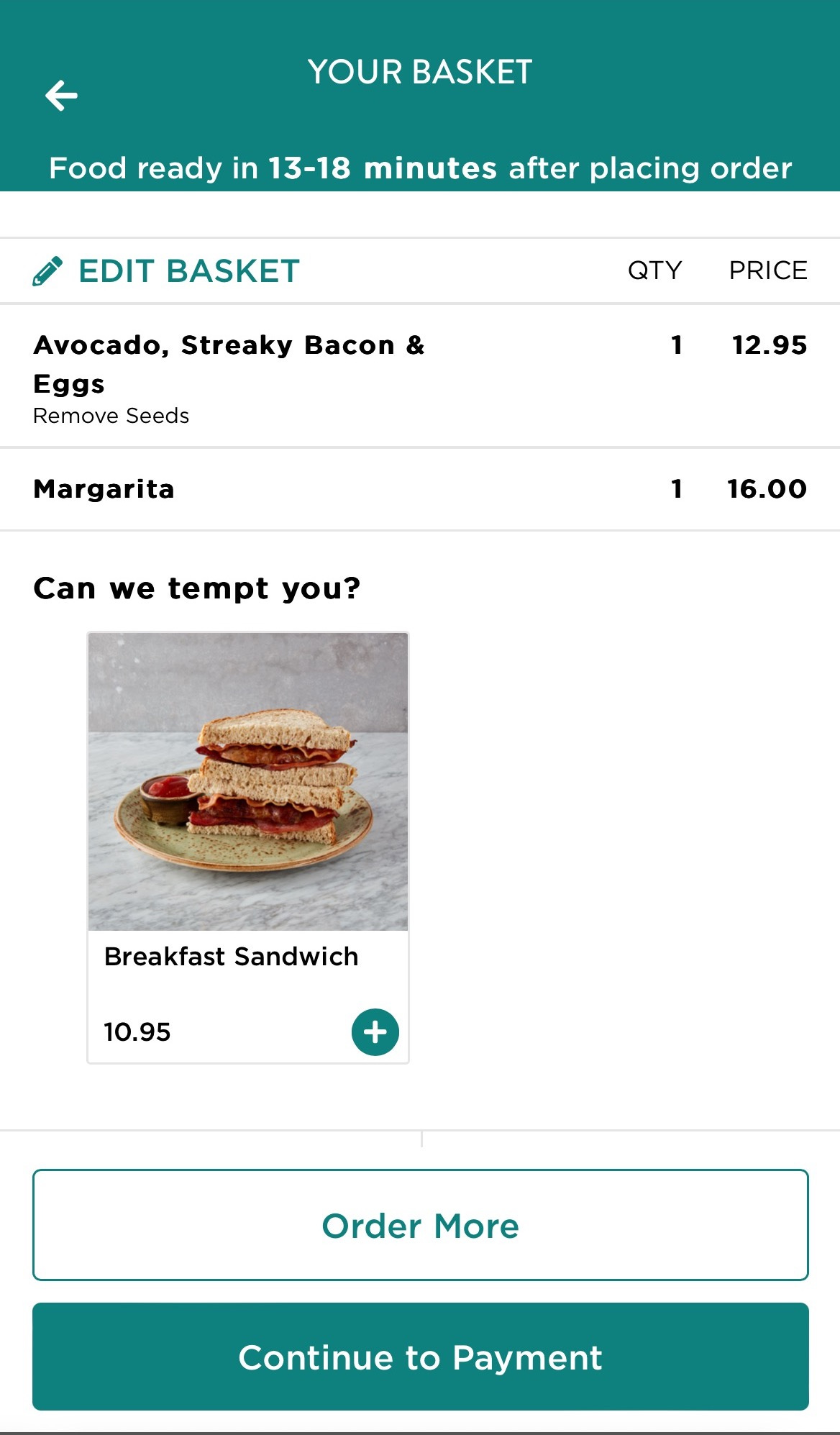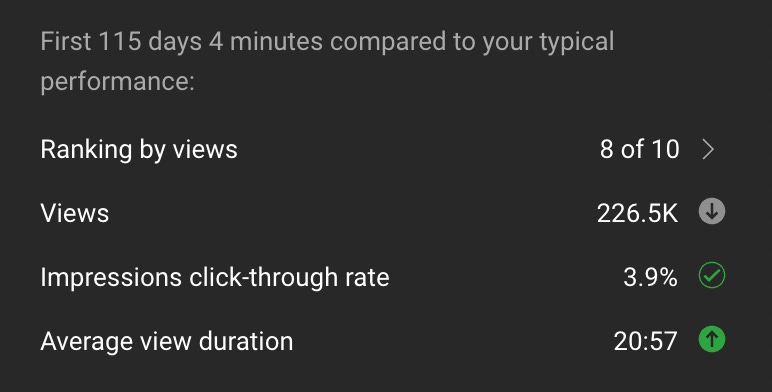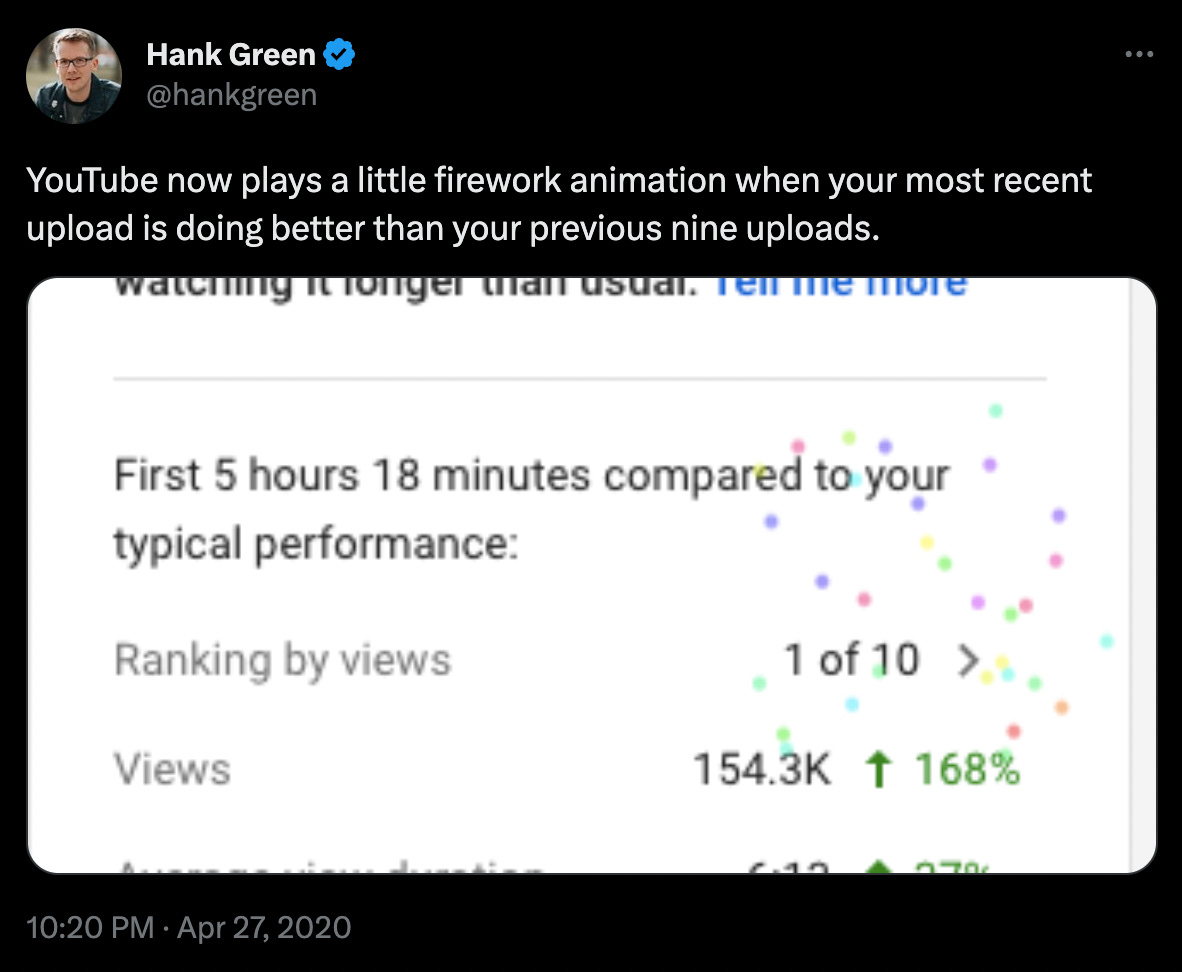The interpreter, without actually erasing or rewriting the text, is altering it. But he can’t admit to doing this. He claims to be only making it intelligible, by disclosing its true meaning.
Susan Sontag, Against Interpretation, 1964

From the perspective of social media analytics, the quality of a post is measured in numbers.
A YouTube video with a million views is better than a YouTube video with only 100 thousand. It’s that simple.
Likes/Retweets/Views/Subscribers/Followers are the ubiquitous video game style stats that make social media what it is. The methods of expression and dissemination are intrinsically tied to numerical measurements, which then become indicative of the inherent value of the post.
This system is as elegant as it is reductive.
These metrics get much more abstract than mere views, however. With a few clicks, you can unlock a comedically overwrought compendium of graphs and data so minute and specific it makes you question the ethicality of it.
These metrics are known as “Analytics.”
Analytics are detailed reports on the performance of your content, available to every user who launches a YouTube channel, Substack newsletter, or Patreon page. You can see them on Twitter, Instagram and Facebook by ticking the “Business Account” box.
You get a real scientific sense from analytics, like you’ve been let behind the scenes into the laboratories. Here are the inner workings, the stark reality undergirding our entertainment. But like so much else online, the appearance of scientific truth is deceptive. The very human curation of this data is rendered invisible beneath a veil of objectivity.
I’d like to analyze the quiet quirks of analytics and how they chip away at your psyche, providing little to nothing in return. If you aren’t someone who is forced to experience these psychological traps, you might still recognize these strategies when they rear their head in your technological life or in your workplace or school. Analytics influence content consumers as much as creators, and their logic can be found from Universities to the highest echelons of corporate finance. In some essential ways, a private individual posting a public Youtube video is subject to the same influences as a CEO with millions of faceless shareholders.
But in order to understand how, we need to cut quite deep into the heart of analytics: the data collection that fuels them, the way this data is interpreted, and the purpose this serves.
Reward & Punishment
Pavlovian conditioning is a raw fact of reality. We are value seeking creatures. We move towards what feels good and away from what feels bad. This motion is what makes us alive; it’s what makes everything struggle for survival over finite resources—from a single cell to entire cities and societies.
Therefore it is the most natural thing in the world—biologically, psychologically, and rationally—to pursue rewards and avoid punishments. If sleeping in every morning results in failing classes, losing jobs, and low self esteem, those punishments will urge us to wake up earlier. Once we start waking up earlier, we might be rewarded with better grades, consistent pay, and respect from others and for ourselves.
Or perhaps we will apathetically choose the rewards of sleeping in despite the punishments. Slacking off feels good, too. No matter what benefits we choose to pursue, they always come balanced with some burdens, and there’s no telling where someone’s value-seeking will take them.
Well, there is some telling.
Humanity has been studying behavioural conditioning for a long time, and corporate marketing has often led the charge. One of the greatest reward/punishment incentives controlling our lives is money. Corporations exist to generate money, and if they have the power to manipulate behaviour en masse, they can do so extremely effectively.
To some degree “manipulating behaviour” is a bit of a dramatic way to describe this. Is it manipulative to communicate the existence of a Good or Service? One might argue that even speaking is a kind of manipulation (making noises with your mouth to mind control your victim). But there’s nothing wrong with honestly conversing, and there’s nothing wrong with creating a Good or providing a Service. Marketing is not inherently evil, and there is not a clean line between altruistic business practices and duplicitous profiteering. However, noticing steady streams of rewards and punishments conveyer-belted to you online can help you sense when you’re in a grey area.
Let’s use an easy example: buttons! Which are bright and tasty to click, and which are sad/grey or bad/red?
Here are 3 fun examples I’ve encountered in the wild recently on a flight from Toronto to Glasgow:

Travel insurance! Should I get it? I don’t know!
I’m travelling with just a carry on (no checked luggage) so I’m not too concerned about lost baggage, it should all be within reach the whole time. I’m not expecting any particular reason I would cancel this flight from Toronto to the UK, and I won’t have any problems finding my gate at the Dublin airport to transfer flights, so I don’t expect I’ll miss connections either. And I’m not really sure what the covered reasons are for a Flight refund, and I kind of just wanna get my flight bought so I’m not opening up that little menu.
But now I have to select which button to click, and one button seems very pleasant and one seems a little stark and scary.
Button one is cozily highlighted in baby blue, shortly and sweetly declaring “Yes! Insure my trip for only CAD 79.67!”
That seems like a smart thing to do. Quick confident affirmative extra protection for less than 100 dollars.
The second button on the other hand seems like signing a death warrant.
“No… I will travel without this insurance for my CAD 995.91 trip. I understand that by declining coverage I may be responsible for all cancellation fees and delay expenses.”
Wow. My CAD 995.91 trip! Do I really want to decline coverage for that? What about the fees and expenses!
What you may have not noticed is the delicate italicized text underneath the appealing option, because it looks boring and unemotional. Yet it is as much an adoption of responsibility as the second option. You are consenting to a disclaimer full of things that your travel insurance won’t cover. So you’re paying even more money than 995.91, and you are also agreeing to a whole lot of limitations on what that exactly buys.
So, should you get travel insurance? I don’t know! It’s a trade off. But what is this software giving you with simple straightforward reward and punishment psychology? Buying travel insurance feels good and not buying travel insurance feels bad. Learning what you could lose if you don’t buy travel insurance is dramatic and easy and anxiety inducing, but learning exactly what you gain if you do buy it is boring and requires extra clicks and extra time.
The actual value exchange is being emotionally interpreted for you before you make a decision, but it’s selling itself to you as objective data with which you may make an informed decision.
This simple button emphasis tactic is absolutely everywhere. The button that makes the company more money is always highlighted, and the one that saves you money is drab and dreary, reminding you of what you’re losing. You’re not immune to this effect or else they wouldn’t bother to do it. And even if you do think you’re immune, do you enjoy being transparently babied like this?
Other instances are not as easy to discern, and don’t even involve any tangible transaction that could possibly benefit the user.
Here’s the particularly egregious portal to access Free Wi-Fi at the Toronto Pearson International Airport.

There’s a familiar rhythm presented to us: submit your email address, tick off the box agreeing to Terms and Conditions, then you gain access to Wi-Fi.
Often, you have to submit data in order to access “free” services.
Your data is constantly harvested and sold. All free social media sites collect copious consumer data and use it to feed you targeted advertisements. When not using your data themselves, they also sell it to other parties.
There are many checkpoints in your regular life where your data will be requested, and often free services are now offered with the metaphorical “paywall” of data collection. You must make an account to access wifi, take this survey, or at least provide your email.
But if you look at this particular gateway twice, you’ll see that incredible admission tucked in the center:
“E-mail address is not required to connect to Wi-Fi”.
So, basically, give us your email in exchange for absolutely nothing. Idiot.
They don’t even explain what they’re going to use it for! No disclaimer that they won’t send you spam, no explanation as to why they require it in the first place.
They’re just taking it from anyone that will passively type their email address out of pure habit.
I think that corporations should at least pretend to be offering me a service in exchange for my personal data. Call me old fashioned.
But I don’t only want to be negative! Here’s a prompt I really relished from a restaurant in the Dublin airport:

(Ignore the sixteen euro margarita)
What an adorable upsell!
Instead of framing the extra product as “People also ordered”, framing it as some unmitigated objective scientific data, they are completely transparent about their intentions and desires.
“Can we tempt you?”
If we wag an extra treat in front of your face, will you give us more money?
Maybe! Who knows!
I think it’s sweet. I can honestly respond to an honest question.
The highlighted buttons on the page also make sense to me.
On one hand, the plus button I could press if I’m “Tempted” is an enticing cyan (would feel nice to press) but so is the biggest button on the screen, which is the straight forward “Continue to Payment” button, while the “Order More” option is de-emphasized.
Simple Pavlovian stuff!
It exists on a spectrum. I won’t actually try to peg any of these interface moments at some objective measurement of morality, but they’re interesting to examine with consciousness of simple Reward/Punishment psychological conditioning.
You’re not immune to it. You don’t always notice it’s happening. And even when you do notice it: You Are Not Immune To It.
Awareness is not enough to actually stop experiencing these fundamental realities. We can scoff at cookie cutter Chevrolet commercials, but when we think about cars we instinctively see the beautiful idyllic images they’ve implanted in our heads. I think the stock footage Imagine Dragons montage is silly, but I can still smell that fresh car, and I on some level am quite convinced a brand new car by one of these big brands would be a wonderful thing to possess.
These things work. They work on you. Otherwise, advertising wouldn’t make up 89% of Twitter’s revenue.
As always, the most powerful effects will take place over time. When you stare at the same subtle valuations every day, every week, every month, they burn themselves into your retinas. Your conscious intellectual evaluation is bypassed, and your subconscious wiring simply adapts.
Analytics
Analytics are the lifeblood of modern online content generation. The biggest moguls obsess over them, optimizing their output for maximum algorithmic impact. They tweak tiny details to increase the average open rate on their Substack article, or the click-through rate on their YouTube video, or the impressions on their Patreon posts.
Often you don’t even need to go looking for these stats to have them force fed to you. Analytics are automatically generated on home pages, placed so that you must go through them to upload a new post.
Perhaps the most infamous shock collar amongst these is the YouTube Creator dashboard. The “Latest Video Performance” summary is well known as a source of torment from tiny hobbyists all the way to well-established creators at the top of the ecosystem.

No wonder for such a slick device. It’s visceral and immediate, telling you directly if your latest efforts are above or below standard.
Whatever your post is, regardless of content, your latest offering will immediately be slotted into a top 10 ranking with everything else you’ve done. You’ve got three options for your remaining stats: grey down arrow (below average), transparent green checkmark (average) and bright green filled in up arrow (above average).
This should give you an oversight of if you’re keeping up with yourself and constantly improving. It will also tell you if your content is waning and you’re losing your audiences attention. But the ultimate reward is reserved for when your video outperforms all others.

It is really impossible to overstate how good it feels when you receive the little confetti fireworks demonstration after uploading a video. It’s the kind of resonant head pat that would have anyone chasing the dragon afterwards.
Ostensibly these analytics are for the benefit of content creators. They are vital signs for a healthy and successful video, markers that guide you towards serving your audience as best you can.
But what tangible effect does the “Latest Video Performance” have? Underneath the appearance of objectivity, what does it do?
Analytics are explicitly and exclusively indicators of profit. They do not tell you the quality of your post, they don’t even tell you if people are enjoying the post or if they hate it. They only tell you the direct monetary value of the content’s performance.
This is data that is useful to a business. YouTube pays you based on how much money you are making them, so if you are trying to turn a profit on YouTube, you must align yourself with their interests. They make the vast majority of their billions by selling ad space in between the content that they host, so the more you can keep the attention of their user base, the more traffic they charge toward advertisers, the higher the value of their ad space, the more money they make, the more they reward you.
Content creators with superb analytics are valuable financial assets to YouTube. So the psychological stimulus they serve creators reflects this. When you have a poorly performing video, they want you to feel like you have failed in some essential, objective way. When your video is driving engagement, they reward you with literal confetti.
Analytics equate financial optimization with personal success and a satisfied audience. They are not for you, they are for YouTube.
Obviously businesspeople who seek to optimize their profits on YouTube are already perfectly aligned with YouTube, but the vast majority of creators have diversified incomes and creative career goals more complex than blind numerical maximization.
The issue with chasing analytics is the same as chasing constant quarterly profits at the expense of any other kinds of value: it’s dehumanizing, destructive to the uniqueness your brand, and not guaranteed.
When you pursue optimized analytics, you forfeit your ability to corner a market. You quickly leap into a race to the bottom, and can quickly find yourself in a situation where you are successful, monetarily reliant on this platform, and unhappy with your audience.
Becoming a successful artist or running a sustainable business is not just about increasing revenue at all costs. It’s about building a fruitful relationship, which requires each individual to find the specific audience that they can serve happily and successfully.
There are two truths I want every single creative and entrepreneur to know deep in their chests as they navigate the incentive structures and analytics that soak all corners of the internet.
- Optimized analytics are not a sign that your business is doing well, only that you are being a good employee for your parent platform. When you let analytics affect your mental health and dictate your creative behaviour, you may well be sacrificing your soul and the long term viability of your business for the sake of pixellated confetti.
- Even if you follow the analytic structure to maximize your profits, IT MIGHT NOT WORK.
This is the ultimate insanity of analytics: even if you sacrifice your individuality for profit, you may not actually receive that profit. No one knows for sure what will work and why, and if you never begin the process of doing what you love, you will never get good at it, and you will never discover if there might’ve been an audience out there for your thing.
Analytics do not exist before you create content. Analytics are a narrow interpretation of the content that we create, and they are delivered to us to keep us anxious about the quarterly profit increase that YouTube is trying to generate. It’s a subtle form of psychological slavery disguised as a disinterested factual report.
At scale this is benignly accepted brainwashing, indoctrinating any impressionable creative in the profiteering logic of shareholders and investors. Your work is constantly reduced to numbers on a spreadsheet, measured by its flat contribution to the valuation of a corporation, and creators are bullied for not being as useful in this 30 day period as they were in the previous 30 day period.
Analytics can be useful, but only when they are interpreted usefully in service of higher values. When you uncritically accept the interpretation fed to you by your parent platform, it blots your existence into quantity without any relevant quality.
I’m not speaking from a victimized mentality here. In the last two years, I built a thriving business between YouTube and Patreon without looking at my analytics once. The first example of YouTube analytics that I displayed above shows my latest video underperforming in view count, but saw a sharp uptick in my Patreon support at the same time.
Further up the ranks, YouTuber Jenny Nicholson reports the exact same habit, boasting over a million subscribers without consulting the mathematical optimization of her highly anticipated and widely celebrated content.
“…yeah I don’t go into the minutia. I’ve seen other people post screenshots of their analytics where YouTube will say ‘You got 20% less views this month’ and… I don’t wanna see that.”
Favourable analytics can coincide with successful careers (and often do), but they are not mandatory. Oftentimes, they only increase distress and hamper the organic creative and entrepreneurial process.
No matter what you create, obvious un-analyzed metrics like views, likes, comments, and profit are the only things that you really need to look at. The more abstract and minute the measurement, the more it belongs to the realm of venture capital accounting departments.
If you ever think of analytics, never forget what they are: tools to optimize profit, designed to induce anxiety, unconcerned with your personal success.
If you can, don’t even look at them. Just create, release, observe, reflect, repeat.
It’s always been that simple.
The Courage To Create
Creating and releasing something requires bravery. It requires uncertainty. It requires commitment to an idea and the vulnerability of being perceived. It’s a highly dynamic and hallowed act to bring something forth from nonexistence into the realm of embodiment—to offer something you made in hopes that others will find it valuable.
Tools like analytics try to reduce this dynamic human process into dead digital math. The insidious automatic overdose of analytics seeks to appear “objective” information provided for your benefit, but it’s carefully curated to increase quarterly profit.
According to quarterly profit logic, if you make 100 dollars today, then 50 dollars tomorrow, that means
“Daily profits have decreased by 50%”
instead of
“You earned 150 dollars.”
This is a deranged molecular way to conceive of creativity that lends no credence to integrity, sustainability, or the simple fact that markets are supposed to fluctuate.
You cannot predict the result of your work, you cannot create an objective formula for success, no spreadsheet will tell you how to make Good things or provide excellent Services. Not even YouTube itself can tell what will be successful and what will not. They can only tell you to panic, to mangle yourself, to contort your content in anxious pursuit of an ever shifting goalpost called Trending. If you follow that lighthouse, you will be nothing more than an animal doing tricks for a trainer.
I think that platforms like YouTube, Patreon Substack and Instagram are wonderful. They’re profoundly liberating to individual creativity and our capacity to form communities for increasingly niche and particular interests. But on a corporate level, they are willing to sacrifice every inch of their dynamic value in order to continue increasing the numbers on their spreadsheets.
Maybe that’s the job of the corporation. But just because they do it doesn’t mean that you have to follow suit.
Don’t let others tell you what quality of content to get good at, or which audience you want. If you allow the quantitative analysis to guide you, you will not build what is best for you, and you still might not succeed.
Remain suspicious of curated analytics, measure success by your individual goals, and always interpret the numbers for yourself.
Or better yet, just ignore them and start making things.
In some cultural contexts, interpretation is a liberating act… In other cultural contexts, it is reactionary, impertinent, cowardly, stifling.
Susan Sontag, Against Interpretation, 1964
